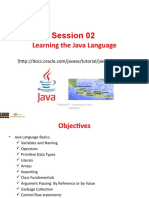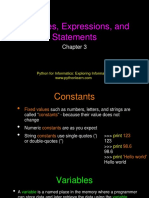Advanced Java (BIS402)
Program 1: Implement a java program to demonstrate creating an ArrayList, adding
elements, removing elements, sorting elements of ArrayList. Also illustrate the use of the
toArray() method.
import java.util.*;
public class ArrayListDemo {
public static void main(String[] args) {
// Creating an ArrayList
ArrayList<String> fruits = new ArrayList<>();
// Adding elements
fruits.add("Apple");
fruits.add("Mango");
fruits.add("Banana");
fruits.add("Grapes");
System.out.println("Initial ArrayList: " + fruits);
// Removing an element
fruits.remove("Banana");
System.out.println("After removing Banana: " + fruits);
// Sorting the ArrayList
Collections.sort(fruits);
System.out.println("Sorted ArrayList: " + fruits);
// Using toArray() method
String[] fruitArray = fruits.toArray(new String[0]);
System.out.println("Array elements: " + Arrays.toString(fruitArray));
}
}
Prof. Arun K H, Dept. of ISE, AIT 1
Advanced Java (BIS402)
Program 2: Develop a program to read random numbers between a given range that are
multiples of 2 and 5, sort the numbers according to tens place using a comparator.
import java.util.*;
// Custom Comparator to sort based on the tens place
class TensPlaceComparator implements Comparator<Integer> {
public int compare(Integer num1, Integer num2) {
int tensPlace1 = (num1 / 10) % 10;
int tensPlace2 = (num2 / 10) % 10;
return Integer.compare(tensPlace1, tensPlace2);
}
}
public class RandomNumberSorter {
public static void main(String[] args) {
Scanner scanner = new Scanner(System.in);
// Input range
System.out.print("Enter the lower bound of the range: ");
int lowerBound = scanner.nextInt();
System.out.print("Enter the upper bound of the range: ");
int upperBound = scanner.nextInt();
// Generate random numbers that are multiples of 2 and 5
List<Integer> numbers = new ArrayList<>();
Random random = new Random();
for (int i = 0; i < 20; i++) {
int num;
do {
num = random.nextInt(upperBound - lowerBound + 1) + lowerBound;
Prof. Arun K H, Dept. of ISE, AIT 2
Advanced Java (BIS402)
} while (num % 2 != 0 || num % 5 != 0);
numbers.add(num);
}
System.out.println("Generated Numbers: " + numbers);
// Sort using custom comparator
Collections.sort(numbers, new TensPlaceComparator());
System.out.println("Sorted based on Tens Place: " + numbers);
}
}
Program 3: Implement a java program to illustrate storing user defined classes in
collection.
import java.util.*;
//User-defined class
class Student {
private int id;
private String name;
private double grade;
public Student(int id, String name, double grade) {
this.id = id;
this.name = name;
this.grade = grade;
}
public String toString() {
return "Student{ID=" + id + ", Name='" + name + "', Grade=" + grade + "}";
}
}
Prof. Arun K H, Dept. of ISE, AIT 3
Advanced Java (BIS402)
public class Main1 {
public static void main(String[] args) {
// Creating a collection to store user-defined objects
List<Student> s = new ArrayList<>();
// Adding Student objects to the collection
s.add(new Student(101, "Arun", 85.5));
s.add(new Student(102, "Madhu", 78.0));
s.add(new Student(103, "Aarohi", 92.3));
// Displaying the students
System.out.println("Student List:");
for (Student x : s) {
System.out.println(x);
}
}
}
Program 4
Problem statement
Implement a java program to illustrate the use of different types of string class
constructors.
Code
public class Main1 {
public static void main(String[] args) {
// 1. Default constructor
String str1 = new String();
System.out.println("str1: '" + str1 + "'");
// 2. String from byte array
byte[] byteArray = {65, 66, 67, 68};
Prof. Arun K H, Dept. of ISE, AIT 4
Advanced Java (BIS402)
String str2 = new String(byteArray);
System.out.println("str2: " + str2);
// 3. String from byte array with offset and length
String str3 = new String(byteArray, 1, 2);
System.out.println("str3: " + str3);
// 4. String from character array
char[] charArray = {'H', 'e', 'l', 'l', 'o'};
String str4 = new String(charArray);
System.out.println("str4: " + str4);
// 5. String from character array with offset and count
String str5 = new String(charArray, 1, 3);
System.out.println("str5: " + str5);
// 6. String from integer array (code points) with offset and count
int[] codePoints = {72, 101, 108, 108, 111};
String str6 = new String(codePoints, 0, 5);
System.out.println("str6: " + str6);
// 7. String from another String
String str7 = new String("Example");
System.out.println("str7: " + str7);
// 8. String from StringBuffer
StringBuffer sb = new StringBuffer("BufferedString");
String str8 = new String(sb);
System.out.println("str8: " + str8);
// 9. String from StringBuilder
Prof. Arun K H, Dept. of ISE, AIT 5
Advanced Java (BIS402)
StringBuilder sb1 = new StringBuilder("BuilderString");
String str9 = new String(sb1);
System.out.println("str9: " + str9);
}
}
Output:
str1: ''
str2: ABCD
str3: BC
str4: Hello
str5: ell
str6: Hello
str7: Example
str8: BufferedString
str9: BuilderString
Program 5
Problem Statement
Implement a java program to illustrate the use of different types of character extraction,
string comparison, string search and string modification methods.
public class Main1 {
public static void main(String[] args) {
// Creating a String
String str = " Java Programming is fun! ";
// 1. length()
System.out.println("Length of the string: " + str.length());
Prof. Arun K H, Dept. of ISE, AIT 6
Advanced Java (BIS402)
// 2. trim()
System.out.println("Trimmed string: '" + str.trim() + "'");
// 3. toUpperCase()
System.out.println("Uppercase string: " + str.toUpperCase());
// 4. toLowerCase()
System.out.println("Lowercase string: " + str.toLowerCase());
// 5. charAt()
System.out.println("Character at index 5: " + str.charAt(5));
// 6. contains()
System.out.println("Contains 'Java': " + str.contains("Java"));
// 7. startsWith()
System.out.println("Starts with ' Java': " + str.startsWith(" Java"));
// 8. endsWith()
System.out.println("Ends with 'fun!': " + str.endsWith("fun!"));
// 9. indexOf()
System.out.println("Index of 'Programming': " + str.indexOf("Programming"));
// 10. lastIndexOf()
System.out.println("Last index of 'a': " + str.lastIndexOf('a'));
// 11. equals()
String str2 = "Java Programming is fun!";
System.out.println("Strings are equal: " + str.equals(str2));
Prof. Arun K H, Dept. of ISE, AIT 7
Advanced Java (BIS402)
// 12. equalsIgnoreCase()
System.out.println("Strings are equal (ignoring case): " + str.equalsIgnoreCase("java
programming is fun!"));
// 13. replace()
System.out.println("Replace 'Java' with 'C++': " + str.replace("Java", "C++"));
// 14. substring()
System.out.println("Substring from index 5: " + str.substring(5));
// 15. substring(start, end)
System.out.println("Substring from index 5 to 15: " + str.substring(5, 15));
// 16. split()
String[] words = str.split(" ");
System.out.println("Split string by spaces: ");
for (String word : words) {
System.out.println(word);
}
// 17. valueOf()
int num = 123;
System.out.println("String representation of number: " + String.valueOf(num));
// 18. concat()
System.out.println("Concatenated string: " + str.concat(" Let's code more!"));
// 19. isEmpty()
System.out.println("Is the string empty? " + str.isEmpty());
// 20. replaceAll()
Prof. Arun K H, Dept. of ISE, AIT 8
Advanced Java (BIS402)
System.out.println("Replace all 'a' with 'o': " + str.replaceAll("a", "o"));
// 21. compareTo()
System.out.println("Compare to another string: " + str.compareTo(str2));
// 22. compareToIgnoreCase()
System.out.println("Compare to another string (ignore case): " +
str.compareToIgnoreCase("java programming is fun!"));
}
}
Output
Length of the string: 28
Trimmed string: 'Java Programming is fun!'
Uppercase string: JAVA PROGRAMMING IS FUN!
Lowercase string: java programming is fun!
Character at index 5: a
Contains 'Java': true
Starts with ' Java': true
Ends with 'fun!': false
Index of 'Programming': 7
Last index of 'a': 12
Strings are equal: false
Strings are equal (ignoring case): false
Replace 'Java' with 'C++': C++ Programming is fun!
Substring from index 5: a Programming is fun!
Substring from index 5 to 15: a Programm
Split string by spaces:
Java
Programming
Prof. Arun K H, Dept. of ISE, AIT 9
Advanced Java (BIS402)
is
fun!
String representation of number: 123
Concatenated string: Java Programming is fun! Let's code more!
Is the string empty? False
Replace all 'a' with 'o': Jovo Progromming is fun!
Compare to another string: -42
Compare to another string (ignore case): -74
Prof. Arun K H, Dept. of ISE, AIT 10
Advanced Java (BIS402)
Program 6
Problem Statement
Implement a java program to illustrate the use of different types of StringBuffer methods
public class Main {
public static void main(String[] args) {
// Creating a StringBuffer
StringBuffer sb = new StringBuffer(" Java Programming is fun! ");
System.out.println("Length of the StringBuffer: " + sb.length()); // 1. length()
System.out.println("Capacity of the StringBuffer: " + sb.capacity()); // 2. capacity()
sb.append(" Let's code more!"); // 3. append()
System.out.println("After append: " + sb);
sb.insert(5, "Awesome "); // 4. insert()
System.out.println("After insert: " + sb);
sb.delete(5, 13); // 5. delete()
System.out.println("After delete: " + sb);
sb.deleteCharAt(5); // 6. deleteCharAt()
System.out.println("After deleteCharAt: " + sb);
sb.replace(5, 15, "Programming"); // 7. replace()
System.out.println("After replace: " + sb);
sb.reverse(); // 8. reverse()
System.out.println("After reverse: " + sb);
sb.setLength(10); // 9. setLength()
System.out.println("After setLength: " + sb);
Prof. Arun K H, Dept. of ISE, AIT 11
Advanced Java (BIS402)
System.out.println("Character at index 5: " + sb.charAt(5)); // 10. charAt()
System.out.println("Index of 'Java': " + sb.indexOf("Java")); // 11. indexOf()
System.out.println("Last index of 'a': " + sb.lastIndexOf("a")); // 12. lastIndexOf()
System.out.println("Substring from index 5: " + sb.substring(5)); // 13. substring()
System.out.println("StringBuffer to String: " + sb.toString()); // 14. toString()
// 15. ensureCapacity()
sb.ensureCapacity(50);
System.out.println("After ensureCapacity(50), capacity: " + sb.capacity());
}
}
Output
Length of the StringBuffer: 28
Capacity of the StringBuffer: 44
After append: Java Programming is fun! Let's code more!
After insert: JavAwesome a Programming is fun! Let's code more!
After delete: Java Programming is fun! Let's code more!
After deleteCharAt: Jav Programming is fun! Let's code more!
After replace: JavProgrammingng is fun! Let's code more!
After reverse: !erom edoc s'teL !nuf si gngnimmargorPvaJ
After setLength: !erom edoc
Character at index 5:
Index of 'Java': -1
Last index of 'a': -1
Substring from index 5: edoc
StringBuffer to String: !erom edoc
After ensureCapacity(50), capacity: 90
Prof. Arun K H, Dept. of ISE, AIT 12
Advanced Java (BIS402)
Program 7:
Demonstrate a swing event handling application that creates 2 buttons Alpha and Beta and
displays the text “Alpha pressed” when alpha button is clicked and “Beta pressed” when
beta button is clicked.
import javax.swing.*;
import java.awt.*;
import java.awt.event.*;
public class AlphaBetaButtons extends JFrame implements ActionListener {
private JButton alphaButton;
private JButton betaButton;
private JLabel messageLabel;
public AlphaBetaButtons() {
// Set the title of the frame
setTitle("Alpha Beta Button Demo");
// Set layout manager
setLayout(new FlowLayout());
// Create buttons and label
alphaButton = new JButton("Alpha");
betaButton = new JButton("Beta");
messageLabel = new JLabel("Press a button");
// Add action listeners
alphaButton.addActionListener(this);
betaButton.addActionListener(this);
Prof. Arun K H, Dept. of ISE, AIT 13
Advanced Java (BIS402)
// Add components to frame
add(alphaButton);
add(betaButton);
add(messageLabel);
// Frame settings
setSize(300, 150);
setDefaultCloseOperation(JFrame.EXIT_ON_CLOSE);
setLocationRelativeTo(null); // Center the window
setVisible(true);
}
// Event handling logic
@Override
public void actionPerformed(ActionEvent e) {
if (e.getSource() == alphaButton) {
messageLabel.setText("Alpha pressed");
} else if (e.getSource() == betaButton) {
messageLabel.setText("Beta pressed");
}
}
public static void main(String[] args) {
new AlphaBetaButtons();
}
}
Prof. Arun K H, Dept. of ISE, AIT 14
Advanced Java (BIS402)
Program 11:
Write a JAVA Program to insert data into Student DATA BASE and retrieve info based on
particular queries(For example update, delete, search etc…).
CREATE DATABASE studentdb;
USE studentdb;
CREATE TABLE students (
id INT PRIMARY KEY,
name VARCHAR(100),
branch VARCHAR(50),
marks FLOAT
);
import java.sql.*;
import java.util.Scanner;
public class StudentDBOperations {
public static void main(String[] args) throws SQLException, ClassNotFoundException {
String url = "jdbc:mysql://localhost:3306/studentDB"; // DB URL
String user = "root"; // Replace with your MySQL username
String password = "Admin123"; // Replace with your MySQL password
Scanner sc = new Scanner(System.in);
// Load JDBC driver (optional for newer JDBC)
Class.forName("com.mysql.cj.jdbc.Driver");
// Establish connection
Connection con = DriverManager.getConnection(url, user, password);
int choice;
Prof. Arun K H, Dept. of ISE, AIT 15
Advanced Java (BIS402)
do {
System.out.println("\n--- Student Database Menu ---");
System.out.println("1. Insert");
System.out.println("2. Update");
System.out.println("3. Delete");
System.out.println("4. Search");
System.out.println("5. Exit");
System.out.print("Enter choice: ");
choice = sc.nextInt();
switch (choice) {
case 1:
System.out.print("Enter ID: ");
int id = sc.nextInt();
sc.nextLine(); // consume newline
System.out.print("Enter Name: ");
String name = sc.nextLine();
System.out.print("Enter Branch: ");
String branch = sc.nextLine();
System.out.print("Enter Marks: ");
float marks = sc.nextFloat();
String insertQuery = "INSERT INTO Students VALUES (?, ?, ?, ?)";
PreparedStatement insertStmt = con.prepareStatement(insertQuery);
insertStmt.setInt(1, id);
insertStmt.setString(2, name);
insertStmt.setString(3, branch);
insertStmt.setFloat(4, marks);
insertStmt.executeUpdate();
System.out.println("Record Inserted Successfully.");
break;
case 2:
System.out.print("Enter ID to update: ");
Prof. Arun K H, Dept. of ISE, AIT 16
Advanced Java (BIS402)
int uid = sc.nextInt();
sc.nextLine();
System.out.print("Enter new Marks: ");
float newMarks = sc.nextFloat();
String updateQuery = "UPDATE Students SET marks = ? WHERE id = ?";
PreparedStatement updateStmt = con.prepareStatement(updateQuery);
updateStmt.setFloat(1, newMarks);
updateStmt.setInt(2, uid);
int updated = updateStmt.executeUpdate();
if (updated > 0)
System.out.println("Record Updated Successfully.");
else
System.out.println("Record Not Found.");
break;
case 3:
System.out.print("Enter ID to delete: ");
int did = sc.nextInt();
String deleteQuery = "DELETE FROM Students WHERE id = ?";
PreparedStatement deleteStmt = con.prepareStatement(deleteQuery);
deleteStmt.setInt(1, did);
int deleted = deleteStmt.executeUpdate();
if (deleted > 0)
System.out.println("Record Deleted Successfully.");
else
System.out.println("Record Not Found.");
break;
case 4:
System.out.print("Enter ID to search: ");
int sid = sc.nextInt();
String searchQuery = "SELECT * FROM Students WHERE id = ?";
PreparedStatement searchStmt = con.prepareStatement(searchQuery);
Prof. Arun K H, Dept. of ISE, AIT 17
Advanced Java (BIS402)
searchStmt.setInt(1, sid);
ResultSet rs = searchStmt.executeQuery();
if (rs.next()) {
System.out.println("ID: " + rs.getInt("id"));
System.out.println("Name: " + rs.getString("name"));
System.out.println("Branch: " + rs.getString("branch"));
System.out.println("Marks: " + rs.getFloat("marks"));
} else {
System.out.println("Record Not Found.");
}
break;
case 5:
System.out.println("Exiting...");
break;
default:
System.out.println("Invalid choice.");
}
} while (choice != 5);
con.close();
sc.close();
}
}
Prof. Arun K H, Dept. of ISE, AIT 18





















































































